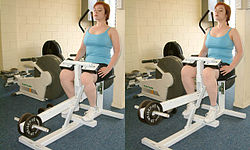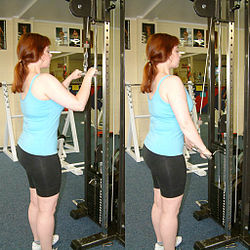This article relies largely or entirely on a single source .(November 2024) |

This is a partial list of weight training exercises organized by muscle groups.
This article relies largely or entirely on a single source .(November 2024) |

This is a partial list of weight training exercises organized by muscle groups.
The human body can be broken down into different muscles and muscle groups that can be worked and strengthened through exercise. This table shows the major muscles and the exercises used to work and strengthen that muscle.
| Exercise | Calves | Quad- riceps | Ham- strings | Gluteus | Hips other | Lower back | Lats | Trapezius | Abdominals | Pectorals | Deltoids | Triceps | Biceps | Forearms |
|---|---|---|---|---|---|---|---|---|---|---|---|---|---|---|
| Squat | Some | Yes | Some | Yes | Yes | Some | Yes | |||||||
| Leg press | Some | Yes | Some | Yes | ||||||||||
| Lunge | Yes | Yes | Yes | Yes | ||||||||||
| Deadlift | Some | Yes | Yes | Yes | Yes | Yes | Some | Some | Some | |||||
| Leg extension | Yes | |||||||||||||
| Leg curl | Some | Yes | ||||||||||||
| Standing calf raise | Yes | |||||||||||||
| Seated calf raise | Yes | |||||||||||||
| Bench press | Yes | Some | Yes | |||||||||||
| Chest fly | Yes | Some | ||||||||||||
| Push-up | Yes | Some | Yes | |||||||||||
| Pull-down | Yes | Some | Some | |||||||||||
| Pull-up | Yes | Some | Some | Some | ||||||||||
| Bent-over row | Yes | Yes | Some | |||||||||||
| Upright row | Yes | Yes | Some | |||||||||||
| Shoulder press | Some | Yes | Yes | |||||||||||
| Lateral raise | Some | Yes | ||||||||||||
| Shoulder shrug | Yes | Some | ||||||||||||
| Pushdown | Yes | |||||||||||||
| Triceps extension | Yes | Some | ||||||||||||
| Biceps curl | Yes | Some | ||||||||||||
| Crunch | Yes | |||||||||||||
| Russian twist | Yes | |||||||||||||
| Leg raise | Yes | Some | ||||||||||||
| Back extension | Some | Yes | Yes | Yes | ||||||||||

The squat is performed by squatting down with a weight held across the upper back (below the neck) and standing up straight again. This is a compound exercise that also involves the glutes (buttocks) and, to a lesser extent, the hamstrings, calves, and the lower back. Lifting belts are sometimes used to help support the lower back. The freeweight squat is one of the three powerlifting competition exercises, along with the deadlift and the bench press. [2]
The leg press is performed while seated by pushing a weight away from the body with the feet. It is a compound exercise that also involves the glutes and, to a lesser extent, the hamstrings and the calves. Overloading the machine can result in serious injury if the sled moves uncontrollably towards the trainer. [3]

The leg extension is performed while seated by raising a weight out in front of the body with the feet. It is an isolation exercise for the quadriceps. Overtraining can cause patellar tendinitis. [4] The leg extension serves to also strengthen the muscles around the knees and is an exercise that is preferred by physical therapists. Needs citation
The wall sit, also known as a static squat, is performed by placing one's back against a wall with feet shoulder width apart, and lowering the hips until the knees and hips are both at right angles. The position is held as long as possible. The exercise is used to strengthen the quadriceps. Contrary to previous advice in this section, this exercise is NOT good for people with knee problems because the knees bear most of the load, especially when they are held at right angles (90 degrees).[ citation needed ]

The deadlift is performed by lifting a weight off of the floor until fully upright. This is a compound exercise that also involves the glutes, lower back, lats, trapezius (upper back), and, to a lesser extent, the quadriceps and the calves. Lifting belts are often used to help support the lower back. If performed with a barbell, it can be held with both hands facing backwards or with one hand facing backward and one facing forward. Both hands should not face forwards because this puts excess stress on the inner elbows.
The stiff-legged deadlift is a deadlift variation where little to no knee movement occurs, increasing hamstring, glute, and lower back activation. The bar starts on the floor and the individual sets up like a normal deadlift but the knees are at a 160° angle instead of 135° on the conventional deadlift.

The leg curl is performed while lying face down on a bench, by raising a weight with the feet towards the buttocks. This is an isolation exercise for the hamstrings. [5]
The snatch is one of the two current olympic weightlifting events (the other being the clean and jerk). The essence of the event is to lift a barbell from the platform to locked arms overhead in a smooth continuous movement. The barbell is pulled as high as the lifter can manage (typically to mid [ chest] height) (the pull) at which point the barbell is flipped overhead. With relatively light weights (as in the "power snatch") locking of the arms may not require rebending the knees. However, as performed in contests, the weight is always heavy enough to demand that the lifter receive the bar in a squatting position, while at the same time flipping the weight so it moves in an arc directly overhead to locked arms. When the lifter is secure in this position, he rises (overhead squat), completing the lift.
The Bulgarian split squat is a squat variation and is performed by resting the back foot on an elevated surface, such as a bench, with your other foot out in front of you on the floor. With a dumbbell in hand or body weight, you bend and lower your front leg until the dumbbell reaches the floor, and then using your front leg, push up into starting position. This exercise targets the hamstrings, glutes, and quadriceps, making it a great full-body movement. This movement also requires good balance and stability, so core strength is also an important aspect.

The standing calf raise is performed by plantarflexing the feet to lift the body. If a weight is used, then it rests upon the shoulders, or is held in the hand(s). This is an isolation exercise for the calves; it particularly emphasises the gastrocnemius muscle, and recruits the soleus muscle. [6]

The seated calf raise is performed by flexing the feet to lift a weight held on the knees. This is an isolation exercise for the calves, and particularly emphasises the soleus muscle. [7]













The back extension is performed while lying face down partway along a flat or angled bench, so that the hips are supported and the heels secured, by bending down at the waist and then straightening up again. This is a compound exercise that also involves the glutes.
The deadlift is a very effective compound exercise for strengthening the lower back, but also exercises many other major muscle groups, including quads, hamstrings and abdominals. It is a challenging exercise, as poor form or execution can cause serious injury. [8] A deadlift is performed by grasping a dead weight on the floor and, while keeping the back very straight, standing up by contracting the erector spinae (primary lower back muscle). When performed correctly, the role of the arms in the deadlift is only that of cables attaching the weight to the body; the musculature of the arms should not be used to lift the weight. There is no movement more basic to everyday life than picking a dead weight up off of the floor, and for this reason focusing on improving one's deadlift will help prevent back injuries.
Wrong technique and forward lean posture with a flexed spine can lead to discal injuries of the lower back. Correct technical performance with a slightly hollow or extended back and a hip hinge to keep the normal curvature of the spine is of utmost importance.
The good-morning is a weight training exercise in which a barbell, two dumbbells, or no weight at all is held on the shoulders, behind the head. The person bends forward and bows at the hips and recovers to upright. The good-morning is so called because the movement resembles bowing to greet someone. It involves the hamstrings but is primarily used to strengthen the lower back; the degree of knee bend used will change the focus – nearly straight-legged involving the hamstrings most.
Incorrect technique and a forward leaning posture with a flexed spine can lead to disc damage in the lower back. Proper technique with a slightly hollow or extended back to maintain the normal curvature of the spine is paramount.